Introduction: Sun exposure during childhood and adolescence is an important risk factor for all skin cancers. Sunlight stimulates a multitude of important biological effects on skin, causing, amongst other pathological and carcinogenesis changes.
Objective: This study was performed to evaluate the knowledge and behaviors among adolescence about the effect of sun`s exposure as a cause of skin cancer.
Material and Methods: In this study, subjects between 14 to 19 years of age were recruited from the high schools in Tirana Albania. The participants were administered a questionnaire consisting of items related to knowledge, attitudes and behaviors related to protection protective behavior against skin cancers and sun protection. Descriptive data related to demographics and responses to the questions are presented.
Results: A total of 104 participants (mean age 17.63±1.08 years) were included. The study included 90(86.5%) male and14(13.5%) female participants. Only 23.1% of adolescents recognized the harmful effects of ultraviolet in skin cancers and melanoma. More than 70% of adolescents had no knowledge about the risks factor for skin cancers and melanoma. More than quarter of them did not apply protective measures during sun bathing. Protective intervention behaviors were more presented to female adolescence compared to male.
Conclusion: Knowledge levels and protective behaviors of adolescence against the harmful effects of the sun and for protection against skin cancers were alarmingly low in the study population. It is necessary to provide educational intervention at adolescence education level. Dermatologic societies and media should intensify the sun protection campaign.
Keywords: Skin cancer, Melanoma, Attitudes, Sun protection
Children and adolescents may be vulnerable to increased ultraviolet radiation exposure and greater risk for subsequent sun-related pathologies.1 Evidence of harm associated with overexposure to ultraviolet (UV) rays is known. Skin cancer is the most common pathology caused by UV radiation, in particular with the frequency of severe sunburns. Exposure to UV rays is therefore a preventable cause of skin cancer.2,3 According to the Center for Disease Control, the incidence rates for skin cancers are increasing, particularly among adults over the age of 65 years4 and melanoma is the third most common form of skin cancer.5
Sunburn is an indicator of both the intensity of a person’s UV exposure and the person’s sun sensitivity. Although use of sun protection has increased slightly in recent years, sunburn prevalence remains high.6,7 As consequence of these burns and the appearance of moles, some of them may develop skin cancer during later years.
Not just countries with high incidence of skin cancers but everywhere now health policy makers design and run programs for educating people for sun protection as an alternative in reducing the incidence of skin cancer and for early cancer detection (primary and secondary prevention campaign). It should also be noted that moderate degree of UV exposure is necessary for the production of Vitamin D which is essential for bone health.
Thus, public health policy on UV radiation needs to aim at preventing the disease burden associated both with excessive and with insufficient UV exposure.8 With this background, understanding knowledge and attitude of adolescents towards sun protection may prove useful measure for reducing the incidence of skin cancer.
The objective of this study was to evaluate the knowledge, attitudes and behaviors of adolescents towards sun protection measures.
Subjects between 14 and 19 years of age from part of high school in Tirana, Albania were recruited for this study. Permission of the ethical committee and the parents' consent in case of children below 18 years of age was taken.
A standardized questionnaire with five sections was prepared and used for each participant. The first section included details related to demographics; age, gender, place of birth, living place and parent’s education, and employment status. Second section of the questionnaire included questions related to skin type, eyes color and presence of moles. Third and fourth parts of questionnaire were related to the knowledge of the effects of the sun on the skin and knowledge about skin cancers and melanoma. Adolescents were asked for recent and previous sunburn history, the use and efficiency of sunscreen and protective measures (like hast, protective clothes, glasses, hours of exposure etc) they use during sunbathing.
Statistical analysis
Continuous variables are presented as mean and standard deviation. Categorical data are presented as frequency and percentages. Differences in demographic data, type of skin, sun exposure and sun protection behavior among different personal characteristics of our participants were examined by using chi-squared test or Fisher’s exact test. Also, regression analyses were conducted with each of the section sun-protection behaviors as dependent measures, controlling for the effects of age, gender, and skin color. P-values less than 0.05 were considered as statistically significant. SPSS version 20.0 was used for statistical analysis.
A total of 104 adolescents with mean+SD age of 17.63±1.08 years were enrolled in this study. Group I (14-16 years of age) included 30(28.8%) participants whereas Group II (17-19 years) included 74(71.2%) participants. The study included 90(86.5%) and 14(13.5%) males and females respectively.
A total of 11(11.6%), 20(19.2%), 51(49%) and 22(21.2%) participants were from class 10, 11, 12 and 13 respectively. Mothers of 1.9% participants had elementary education. A total of 55.76% and 57.70% participant’s father and mother had high school education respectively Table 1.
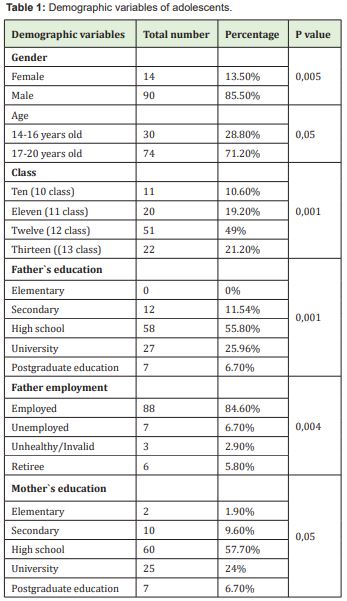

Phenotype data referring the general characteristic of type of skin, color of eyes and hairs of the participants are presented in Table 2. Most of adolescents had brown color skin and this color was maximum in both genders. Natural hairs also had predominance of brown color. Dark brown color represented high number among participants of both genders. Most of participants had brown eyes. Adolescents with green and black eye color were 13(12.5%) and 11(10.6%) respectively.
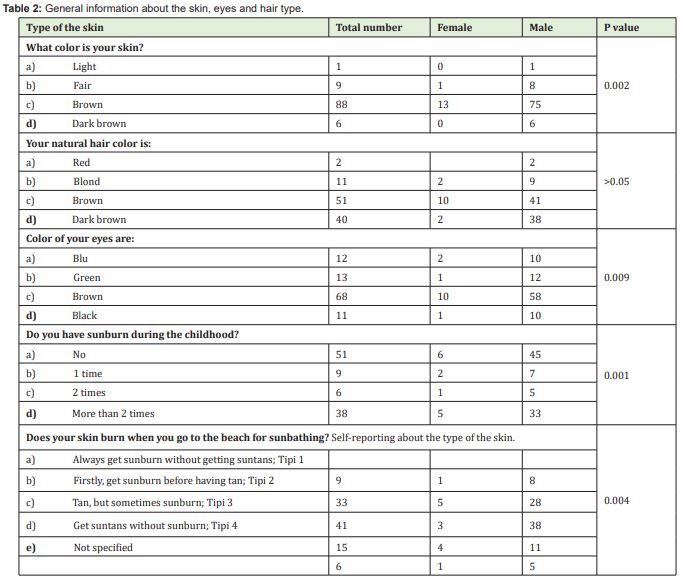

A total of 9(8.7%) of adolescents reported that always get sunburn without getting suntans (1 females, 8 males); 33(31.7%) mentioned that they get sunburn before having tan (5 females, 28 males); 41(39.4%) reported that almost have tan but sometimes sunburn (4 females, 11 males) whereas 15(14.4%) adolescents get suntans without sunburn (4 females, 11 males). Six (5.8%) participants did not answer this session (1 female and 5 males).
A total of 11(10.6%) adolescents did not have mole on their body whereas 79 participants (76 %) reported to have 10-50 moles. About 50-100 moles were present in 10(9.6%) adolescents and more than 100 moles in 4(3.8%) participants. Only 9(8.6%) controlled the moles with a medical staff whereas 95(91.4%) did not control them. There was significant difference in the skin color, eyes color, skin burn when going to the beach for sunbathing, presence of mole on the body and control of mole based on the gender of participants Table 2.
A total of 66.3% and 76% adolescents had knowledge about the suntan and sunburn from UV rays respectively. Fifty one percent participants knew that prolonged exposure to the sun causes freckles and 38.5% knew that it causes wrinkles. A total of 28.8% of adolescents had good knowledge about risk of skin cancer with UV rays whereas 83.6% of them knew that exposure between 11:00 a.m to 4.00 p.m is too harmful.
A total of 70.2% participants knew that sunscreen provides protection from UV rays whereas 55.7% knew that sunscreens with a sun protection factor <15 cannot protect them and 75% knew that one application of sunscreen protects their body for at least 4 hours Table 3.
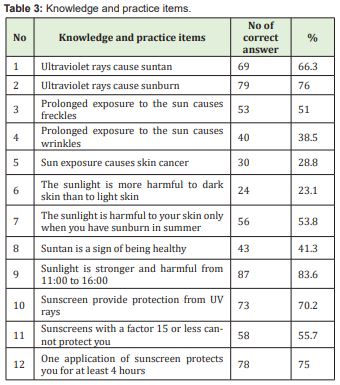
Knowledge about melanoma as a malignant skin cancer was present in only 24.03% whereas 75.7% had no knowledge about this. A total of 23.07% of adolescents thought that nothing can prevent skin cancer and that melanoma is the most dangerous type of skin cancer that can cause death whereas 51% had an opinion that frequent sunburns in childhood can increase the risk of skin cancer in older age. Correct answers to the questions related to number of moles in an individual is related to the risk of developing melanoma and skin ages faster after staying longer in the sun were provided by 35.6% and 45.2% participants Table 4.
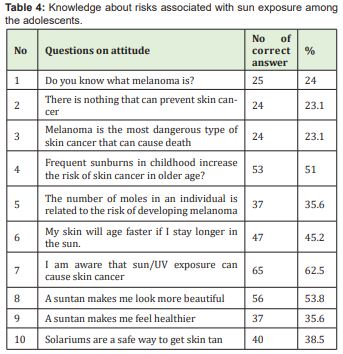
Table 5 shows self-reported sun protection behaviors and attitudes of during the sunlight harmful time among male and female participants. Female have a predominance in almost all of strategies regarding sunscreen usage and measures for harmful sunlight and protection of their body.
A total of 12(85.7%) females reported using sunscreen as compared to 32(35.5%) males. Sunscreen/sun oil with sun protection factor 30-50 were used by most of adolescents that reported sunscreen as protective measures (64.3% female and 18.9% male). Most of them said that during the sunlight harmful time they stay in the shade and/or use umbrella instead of leaving the beach. Meantime female had predominance in wearing hat or sunglasses. Male had predominance only in wearing clothes that protect body during the harmful sunlight time Table 5.
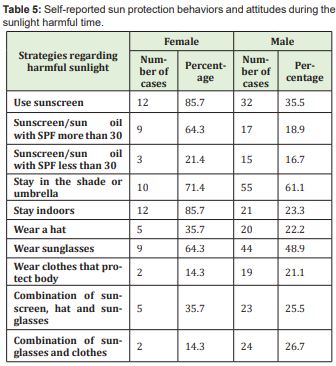
Adolescents are an important target group for sun protection interventions.9,10 Sun exposure during childhood and adolescence is thought to be of particular importance for skin cancer risk across the life span.11,12 New ways of encouraging adolescents to use sun protection strategies are needed to overcome substantial barriers resulting in highly suboptimal levels of sun protection enactment.13
In this study we attempted to find the knowledge, attitudes and practices of adolescents from a high school regarding the effect of sun`s exposure as a cause of skin cancer. In our study, most of participants were males with large proportion belonging to the age group of 17-20 years. Professional high school, the site of study may explain the predominance of male participants than females. The school from which students were selected for the study also has a different study system; it has four study classes from grade 10 to grade 13 unlike other high schools with only grades from 10 to 12. The average grade of the adolescents in our study population was 11.8. Our study population was majorly from class 12 and 13.
Many studies have reported that the ability of sunscreen use, prevent skin cancer and aging.14-17 In this study. levels of knowledge among adolescents about the effects of sun`s exposure varied. Knowledge on effects of sun`s exposure in causing of skin cancer, was poor, but knowledge regarding the harmful sunlight time was good.
Many studies have been reported the used of sunscreen protection measure regarding the sunlight UV.18-21 Knowledge regarding protection provided by sunscreen against UV rays was good in large number of participants. Lesser number of participants than this knew that using a sunscreen cream with a sun protection factor 15 or less cannot protect them. Three fourth participants knew that one application of sunscreen cream protects body for at least 4 hours.
Paradoxical with knowledges of adolescents about sunscreen use and its effect on skin protection, the behavior of participants was unsatisfactory. Hence, practice of using sunscreen was low. The prevalence was almost the same with another study conducted in Turkey that evaluated knowledge, attitudes, and behaviors regarding sun protection, effects of the sun, and skin cancer among Turkish high school students and teachers.22 Another study conducted in Switzerland reported a much higher prevalence of using sunscreen.23
In our study, female adolescents were significantly more aware of the protection offered by sunscreen and protective measures. Practice of using sunscreen was also more prevalent in females, probably due to their better knowledge than male participants. The divergence could be due to image-consciousness and appearance-focused nature of women compared to men.24 Female predominance in sunscreen usage is also reported in other studies.25-27
Small sample size, cross-sectional study design and subjective responses are important limitations of this study. Larger, prospective studies are required to confirm these observations.
Knowledge levels and protective behaviors of adolescence against the harmful effects of the sun and for protection against skin cancer were alarmingly low. Protective intervention behaviors were more commonly practiced by female adolescents than male adolescents. We strongly recommended to provide education to school and college going students about sun safety or skin cancer prevention. Dermatologist, societies of dermatology and venerology, society and media should work in collaboration to maximize the reach of educational initiatives.
EC, IZ, MF, EV: Conceptualization of the article, writing the draft, literature search, review of the draft, approval of the draft
AP and MG: Review of the draft, revision of the draft, approval of the draft
None.
None.
Author declares that there is no conflict of interest.
- 1. Patel AR, Zaslow TL, Wren TAL, et al. A characterization of sun protection attitudes and behaviors among children and adolescents in the United States. Preventive Medicine Reports. 2019;16:100988.
- 2. The Lancet Editorial Board. Skin cancer: prevention is better than cure. Lancet. 2014;384:470.
- 3. Brinker TJ, Faria BL, Gatzka M, et al. A skin cancer prevention photo ageing intervention for secondary schools in Brazil delivered by medical students: protocol for a randomised controlled trial. BMJ Open. 2018;8:e018299.
- 4. CDC. Skin Cancer Prevention Progress Report U.S. Department of Health and Human Services Centers for Disease Control and Prevention National Center for Chronic Disease Prevention and Health Promotion Division of Cancer Prevention and Control. 2019.
- 5. Rogers HW, Weinstock MA, Feldman SR, et al. Incidence estimate of nonmelanoma skin cancer (keratinocyte carcinomas) in the U.S. population, 2012. JAMA Dermatol. 2015;151:1081–1086.
- 6. Holman DM, Ding H, Berkowitz Z, et al. Sunburn prevalence among U.S. adults, National Health Interview Survey 2005, 2010, and 2015. J Am Acad Dermatol. 2019;80(3):817–820.
- 7. Kann L, McManus T, Harris WA, et al. Youth risk behavior surveillance-United States, 2017. MMWR Surveill Summ. 2018;67(8):1–114.
- 8. Ultraviolet radiation. WHO.
- 9. Holman DM, Watson M. Correlates of intentional tanning among adolescents in the United States: a systematic review of the literature. J Adolesc Health. 2013;52(5 Suppl):S52–S59.
- 10. Peacey V, Steptoe A, Sanderman R, et al. Ten-year changes in sun protection behaviors and beliefs of young adults in 13 European countries. Prev Med. 2006;43(6):460–465.
- 11. Armstrong BK, Kricker A. The epidemiology of UV induced skin cancer. J Photochem Photobiol B. 2001;63(1):8–18.
- 12. Autier P, Doré JF. Influence of sun exposures during childhood and during adulthood on melanoma risk. EPIMEL and EORTC Melanoma Cooperative Group. European Organization for Research and Treatment of Cancer. Int J Cancer. 1998;77:533–537.
- 13. Pettigrew S, Parnell A, Strickland M, et al. The potential of ultraviolet radiation meters in secondary schools as a sun protection intervention mechanism for adolescents. Int J Environ Res Public Health. 2020;17:1137.
- 14. Ananthaswamy HN, Loughlin SM, Cox P, et al. Sunlight and skin cancer: inhibition of p53 mutations in UV-irradiated mouse skin by sunscreens. Nat Med. 1997;3(5):510–514.
- 15. Hughes MC, Williams GM, Baker P, et al. Sunscreen and prevention of skin aging: a randomized trial. Ann Intern Med. 2013;158(11):781–790.
- 16. Naylor MF, Farmer KC. The case for sunscreens. A review of their use in preventing actinic damage and neoplasia. Arch Dermatol. 1997;133(9):1146-1154.
- 17. Randhawa M, Wang S, Leyden JJ, et al. Daily use of a facial broad-spectrum sunscreen over one-year significantly improves clinical evaluation of photoaging. Dermatol Surg. 2016;42(2):1354–1361.
- 18. Zhou M, Zhuang W, Yuan Y, et al. Investigation on vitamin D knowledge, attitude and practice of university students in Nanjing, China. Public Health Nutr. 2016;19:78–82.
- 19. Memon MM, Manzoor M, Ashrafi MM, et al. Prevalence and predictors of the use of sunscreen amongst medical students: A multi-center cross-sectional study. Cureus. 2019;11:e4926.
- 20. Rasmussen S, O'Connor RC. Factors influencing anticipated decisions about sunscreen use. J Health Psychol. 2005;10:585–595.
- 21. Al Robaee AA. Awareness to sun exposure and use of sunscreen by the general population. Bosn J Basic Med Sci. 2010;10:314–318.
- 22. Şenel E, Süslü I. Knowledge, attitudes, and behaviors regarding sun protection, effects of the sun, and skin cancer among Turkish high school students and teachers. Dermatologica Sinica. 2015;33:187–190.
- 23. Reinau D, Meier C, Gerber N, et al. Sun protective behaviour of primary and secondary school students in North-Western Switzerland. Swiss Med Wkly. 2012;142:13520.
- 24. Rozin P, Fallon A. Body image, attitudes to weight, and misperceptions of figure preferences of the opposite sex: a comparison of men and women in two generations. J Abnorm Psychol. 1988;97(3):342–345.
- 25. Dupont L, Pereira DN. Sun exposure and sun protection habits in high school students from a city south of the country. A Bras Dermatol. 2012;87(1):90–95.
- 26. Lowe JB, Borland R, Stanton WR, et al. Sun-safe behaviour among secondary school students in Australia. Health Educ Res. 2000;15(3):271–281.
- 27. Tempark T, Chatproedprai S, Wananukul S. Attitudes, knowledge, and behaviors of secondary school adolescents regarding protection from sun exposure: a survey in Bangkok, Thailand. Photodermatol Photoimmunol Photomed. 2012;28(4):200–206.

